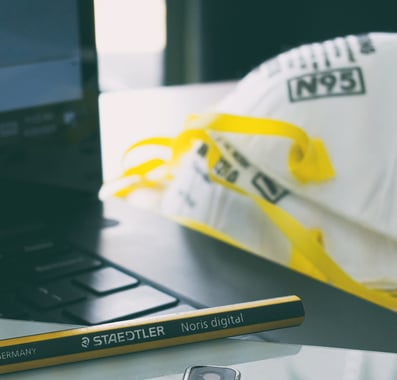
Absco Solutions is considered an essential service under state and federal standards for its maintenance and implementation of life-safety and security system critical infrastructure. As such, we have not stopped operations but the way we conduct day-to-day business has changed significantly. As the COVID-19 situation has evolved so have our procedures and they will continue to as new information becomes available. We share with you what we have learned and we’re hoping to save you and your team some effort in reopening and operating your facilities in the weeks and months ahead.
Mitigate exposure to COVID-19 to the extent possible to: employees, clients, and community.
Increased Personal Protective Equipment (PPE)
- Equip your facilities and personnel with disinfectants, hand sanitizer, masks, and protective gloves. This can be an effective first line of defense, but PPE is only effective if you have ready access to them. This can be set up as a service with partners like Fikes. Some organizations are also adding Plexiglas separation, as may be the case at your local grocery store, or other physical barriers between work spaces. Wearing a mask in common areas. Follow CDC guidelines CDC Cloth Face Covering Recommendations
Increase Facility Cleaning


- The run on Lysol wipes at Costco says it all. We’re all cleaning more frequently and more thoroughly. CDC Cleaning Guidelines
Restrict who, when and how many at a time, enter facilities


- The shift to a remote work force - The biggest challenge is maintaining secure firewalls and effective Cyber Security.
- Limit or restrict shared resource usage items and clean between users - Areas like the kitchen with common refrigerator, coffee machine, and microwave or the copier are places to consider limiting and restricting usage of.
- No large gatherings - Limit at office meetings and reduce in person attendance.
- By appointment only - Limit visitors to your facilities from outside your closed system to reduce risk. By appointment only enables extra precautions to be taken including staffing for cleaning.
- Signage restricting access to people with COVID-19 symptoms - Restrict your facility use by anyone exhibiting symptoms of the COVID-19 virus or a fever of 100.4 or higher.
HR stay at home when sick policies


- Team Member Surveys - Set up an electronic check-in system for all members of your organization to verify each day they are not presenting a risk of exposure to others. This can be accomplished through companies like Take Action and allow for a summary information report to all supervisors.
- Temperature monitoring - This can be as simple as a contactless thermometer or one of many standalone systems designed to visually determine a person’s body temperature as a means of allowing entry such as this one from Dahua and long term members of the thermal imaging sector are using these for body temperature.
Developing the ability to provide contact tracing
Access control managing logging tools
- Access control systems can provide a log of which employees were at the facility on any given day if they are required to card or code in every day. If you have electronic access control and rely on occupant limits to meet compliance in your facility, modern access control platforms can utilize exit readers and track how many people are in specific areas, limit occupants and provide alerts.
Visitor management tools
- Written Logs - A log of all who are entering the facility with the date, time, and contact information so if there is exposure they can be notified to get tested. If they test positive, knowing who they met and came in contact with will also be valuable
- Technology based platforms - Like EasyLobby, they can track those who have come in. Part of visitor management should include an acknowledgement that they are compliant with a health statement with either method of tracking. This allows for contact tracing and information around potential exposure as well as physical security for your facility.
Video surveillance as a resource
- Occupancy level analytics - There are camera analytics that can monitor occupancy levels in a room which may provide insight into social distancing adherence.
- Tracing of an individual through a facility - Facial recognition can be utilized to follow an individual through a video surveillance platform and identify potential contacts if a positive case needs to be traced for surface cleaning and personnel notification.
A special thank you to Steve Porter of Coughlin, Porter and Lundeen for contributing to this article and to Mark Simms and the rest of the Fikes’ team for your support.

